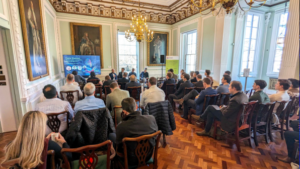5 steps to take when embarking on digital transformation projects
As government departments face further austerity measures, the pressure is on to bring in more savings, and to make it happen quickly. Departments have been urged to make bold decisions, and take decisive action. But there are many examples of the chaos that can ensue when governments make bold decisions but execute them poorly – just take the Indian government’s decision to withdraw the rupee so fast that led to citizens being unable to exchange their cash.
It is crucial that governments realise that change requires change management – and digital transformation represents a huge change for many governments. Digital transformation is a serious undertaking. It’s not about adding automated capabilities to analogue procedures or replacing paper-pushers with screen-jockeys. A truly digital government department isn’t just about the technology – although it naturally plays a huge part. It’s often about having a lean, fit-for-purpose set of processes unencumbered by traditional ways of working or old ways of thinking.
Instead, it’s about re-engineering the department around a digital capability and, if necessary, re-inventing its processes from the ground up. You also need the right people to take on the job.
We’ve seen waves of digital hipsters brought in from startups and private sector to transform government. Although they have done something similar before, digitally transforming a government department is a much bigger task. The old IT folk are getting pushed out or moved on to other projects. But it is those mature experts – with years of experience – who are able to help identify pitfalls and truly transform government departments. It’s a mammoth task, and you need to get the entire team on board, making sure that cultural change is embedded throughout your department. Otherwise, it will fail.
With that in mind, here are our top five lessons for all governments to consider.
Lay A Solid Foundation
Getting the fundamentals right is essential for any change management programme. This means having a clear vision of what you want your digital government to look like and the benefits to be delivered. Secure buy-in and leadership from the top. Since a digital transformation is likely to have an impact on every role within a department, ensure that everyone understands and is engaged in the project.
Plan And Coordinate Properly
It’s always tempting to respond immediately to the latest technology launch, market development or competitor announcement. But it’s rarely a good idea. Be clear about your team’s goals and how far and how fast you want to change.
Prepare People For The Digital Future
A truly digital government department is rarely static and usually requires fast decision-making. Successes are likely to be incremental, and where failures occur they need to be fast and the team must move on quickly. Different management styles may be needed, especially as digital transformation can cause unexpected or unwanted shifts in power relationships.
Expect to support both dented egos and vastly altered career expectations throughout your team. Encourage managers who have learnt to operate in the analogue era to learn how to use big data to guide their decision-making.
Keep Focused On The Bigger Picture
Don’t get distracted by day-to-day events or minor adaptations to existing procedures. Distinguish between short-lived trends and major new movements in the marketplace, and avoid getting bogged down by the nitty gritty technology risk assessment, widgets and apps. The goal is public sector transformation. Digital tools are simply the enablers.
Remember That Goal Posts Are Always Moving
The pace of change is so fast that the move to digital will always be a dynamic project – with new opportunities and challenges continuously emerging. It’s all about agile development and flexible progress: monolithic IT installations are yesterday’s dinosaur.
Good planning, coordination and maintaining your focus will help you meet these moving targets.
But, you also need to decide how far you want to move away from the traditional model and established government purpose. Going digital can be distracting and confusing, and governments can lose their way by moving too fast and changing too much, and so lose sight of the things that currently make them successful. Move too slowly and the world moves on without you. Innovate at the pace that suits you.
Finally – the simplest and the hardest rule of all: Be prepared to change everything.
Article originally published on PublicTechnology.net
Latest content
-

From ScanApp to Lego demos — What you need to know about Security & Policing 2025
Published on: 1 April, 2025 -

Truth, trust and transformation — 4 key takeaways from Zaizi’s AI in government event
Published on: 14 March, 2025 -

Zaizi talent shines at Computing DevOps Excellence Awards 2025
Published on: 13 March, 2025 -

Advancing DevOps practices with AI —lessons from AWS re:Invent
Published on: 10 March, 2025
